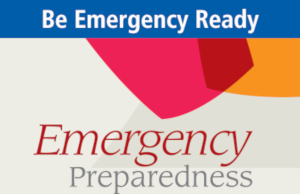- FROM THE TOP:
- Are You Prepared for an Emergency?
- June is National Indigenous History Month
- POLAR’s Social Media Etiquette
- POLAR’S PEOPLE:
- Building a Traditional Indigenous Sled at the CHARS Campus
- Inuit Tapiriit Kanatami’s “A Taste of the Artic” Event
- LEARNING AND PERFORMANCE
- Indigenous Learning Series
- Inuktitut/Inuinnaqtun Word of the Week
- Are you ready to Talk the Talk?
- WORKPLACE NOTICES:
- Information Management Tip of the Week
- UPDATES:
- POLAR Events Calendar
- Key Outcomes from Senior Management Committee
FROM THE TOP:
Are You Prepared for an Emergency?
Risk reduction strategies can and do make a positive difference when it comes to personal and organizational safety. Knowing what to do is an important part of being prepared. Follow these three easy steps to get you and your family prepared in case of an emergency.
- Know the risks: Across Canada, we face a number of natural hazards, which can vary from region to region. Knowing what to do is an important part of being prepared. Find out about risks in your region and how to prepare for different situations here.
- Make a plan: Emergencies happen when we don't expect them, and often when families are not together. Having a family emergency plan will save time and make real situations less stressful. Take a few minutes to create your family emergency plan online.
- Get a kit: In an emergency, you will need some basic supplies. You may need to get by without power or tap water. Be prepared to be self-sufficient for at least 72 hours. Check out this video on how to prepare a family emergency kit.
Want to learn more? Click here for additional tips and tools on the Government of Canada’s official emergency preparedness website.
June is National Indigenous History Month
Coming up in June is National Indigenous History Month recognizing the historic contributions of Indigenous peoples from across Canada throughout its history. This celebratory month has been recognized since 2009 and provides an opportunity to highlight the strength of present-day Indigenous communities and their promise for the future.

Some important topics that relate to modern and contemporary Indigenous issues in Canada include Reconciliation & Residential schools. As POLAR often interacts and engages in dialogue with Indigenous peoples, we as an organization have a duty to stay knowledgeable about their history and culture. This greater understanding of First Nations, Inuit & Metis peoples will lead to a stronger bond between our organization and Indigenous communities.
Find out about the history of Indigenous peoples, successful community-driven projects that improve their lives, as well as Indigenous arts, culture and heritage here.
June 21st is the official date of National Indigenous Peoples Day. Keep an eye out for the next issue of the POLAR XPRESS that will feature more details on the various key events from coast to coast to coast!
POLAR’s Social Media Etiquette
Here at POLAR we pride ourselves on our growing social media presence and engagement; however it is important to remember the dos and don’ts when utilizing social media.
POLAR is currently active on:

Twitter: @POLARCanada | @POLAIRECanada

Facebook: Polar Knowledge Canada | Savoir polaire Canada

Instagram: polar.knowledge | savoir.polaire

YouTube: Polar knowledge Canada | Savoir polaire Canada
- Social media dos:
- We know that people want to share their experiences on social media. The best way to support POLAR on social media is by liking, sharing, and re-tweeting posts from the POLAR official pages.
- Social media don’ts:
- Do not copy and paste POLAR content and post it as your own.
- Do not reply to other comments that have been made on POLAR’s social media posts (including do not like or share other comments)
- Do not create and post social media content that gives the impression that you are a spokesperson for POLAR.
- Do not comment on POLAR posts.
As our social media presence broadens, these easy to remember rules, regulations & guidelines will help us navigate our increasingly connected society.
Check out POLAR’s Social Media Guidelines on the intranet. For any comments, concerns or suggestions regarding social media in the workplace please contact communications@polar.gc.ca.
POLAR’S PEOPLE
Building a Traditional Indigenous Sled at the CHARS Campus
On May 6, POLAR staff was hard at work building the SmartQAMUTIK at the CHARS campus. As it moves along, pulled by a snowmobile, this sled will measure sea-ice thickness. The SmartQamutik is to be used as part of the SmartICE project to mitigate the risks of on-ice travel in Cambridge Bay in response to climate change challenges.
SmartICE is designed to augment Inuit Knowledge with novel technology, positioning northern communities to better maintain traditional livelihoods and cultural practices in the wake of a warming Arctic and unprecedented sea-ice conditions.
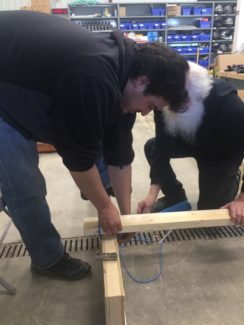
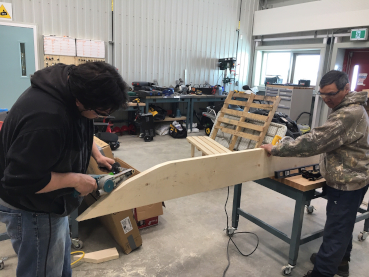
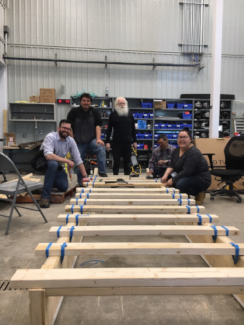
Traditional qamutik quick facts:
- The runners and cross-pieces of a qamutik are not held together with nails or pins, which would make the construction too brittle for arctic conditions. Instead, each piece is drilled and lashed to the next, providing a flexibility of movement that can endure the pounding of travel on open sea ice.
- The packing and lashing of a sled is an art. Weight must be carried low on the sled, to reduce the risk of tipping.
- In earlier times, before Inuit had access to lumber, they built qamutiit out of whatever material was available: driftwood, bone – or even frozen fish!
Inuit Tapiriit Kanatami’s “A Taste of the Artic” Event
On May 15, POLAR’s President and CEO, Dr. David J. Scott, Jennifer Sokol and Marie-Eve LaRocque attended the Inuit Tapiriit Kanatami’s A Taste of the Arctic event at the National Arts Centre in Ottawa.
This event drew hundreds of influential decision-makers and foodies seeking to sample Arctic cuisine. It also showcased Inuit culture and talented performers demonstrating modern connections to the long-standing traditions that keep Inuit culture vibrant.
“This was a wonderful event to get acquainted with Inuit leaders, organizations and musicians from Inuit Nunagat. A Taste of the Arctic was a great opportunity to discover distinctive northern food and Inuit culture in a vibrant setting” said Marie-Eve of her participation in the event.
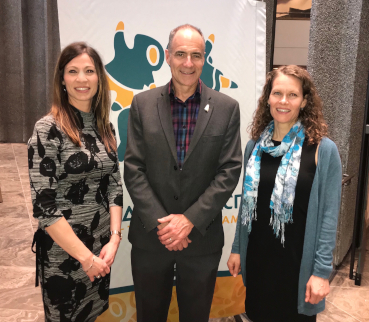
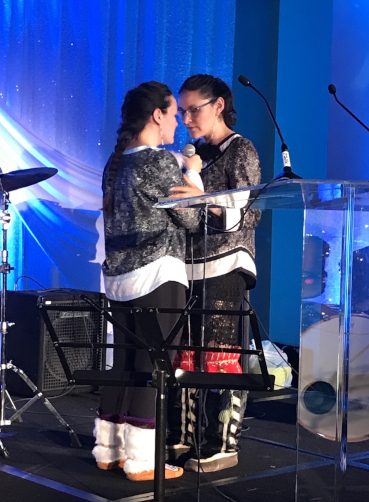
LEARNING AND PERFORMANCE
Indigenous Learning Series
The Canada School of Public Service (CSPS) has recently developed the Indigenous Learning Series to provide opportunities for public servants to increase their cultural competence and awareness of First Nations, Métis, and Inuit in Canada.
This learning series offers a wide range of short videos in an easily viewable experience:
- The Memoirs of Russell Moses: Residential School Survivor
- Senator Sinclair on Truth and Reconciliation
- Leaders Panel
- Reconciliation through Art
- What Does Indigenous Mean?
- Why I joined the Public Service
- The Path of Reconciliation
“At every level of the public service, the insights gained through this series will support working effectively with diverse Indigenous populations and developing federal policies and programs to meet the unique needs and realities of Indigenous peoples in Canada.” – Canada School of Public Service
To view these videos and for more information about the government’s efforts to help rebuild and restore indigenous heritage, click here.
Inuktitut/Inuinnaqtun Word of the Week
Katimavik - ᑲᑎᒪᕕᒃ
The Inuktitut and Inuinnaqtun word of the week is katimavik. It means “meeting place (board room)”. It is pronounced: ku-tee-mu-veek.
Listen to the pronunciation here
Are you ready to Talk the Talk?

WORKPLACE NOTICES
Information Management Tip of the Week
In this week’s Information Management (IM) tip of the week, Renée shows us how to manage email messages by using rules. Follow these easy guidelines to make email management a breeze!
Rules allow you to move, flag, and respond to email messages automatically. You can also use rules to play sounds, move messages to folders, or display new item alerts. The easiest and most common rule to create is one that allows you to move an item from a certain sender or with certain words in the subject line to another folder. You can create this rule directly from a message you’ve already received.
| Windows Users | Mac Users |
|---|---|
Right-click a message and select Rules. | Select a message and click on Rules in the toolbar. |
Select Always Move Message From: 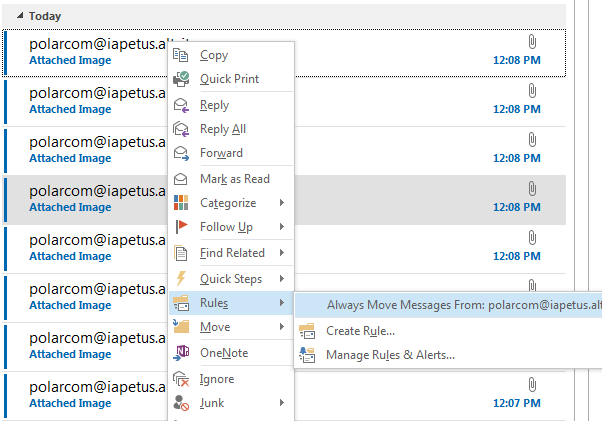 | Select Move Messages from 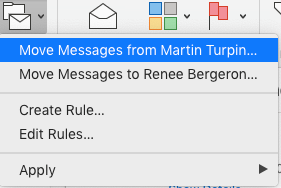 |
| In the Create Rule dialog box, select one or more of the first three checkboxes. | Type the name of the destination folder and click Choose. |
| In the Rules and Alerts window, select the folder from the Choose a folder list, and then click OK. | All new emails and previously received from the selected Sender are automatically moved to the destination folder. |
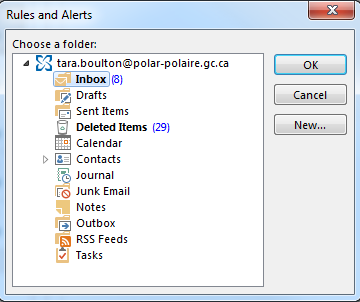 All new emails and previously received from the selected Sender are automatically moved to the destination folder. |
For more information on how to use these email functionalities, please contact Renée at renee.bergeron@polar.gc.ca.
UPDATES
POLAR Events Calendar
You will find below the latest version of the POLAR events calendar, including upcoming events and conferences for your information.
Note: The calendar is subject to change. Any travel has to be pre-approved by Directors (and above for international destinations).
Please send any calendar updates or additions to Regienna by email at regienna.baggayan@polar.gc.ca and cc Amber McMachen at amber.mcmachen@polar.gc.ca.
POLAR events calendar: May 22, 2019
Key Outcomes from Senior Management Committee
Here are the key outcomes and decisions deriving from the May 8 Senior Management Committee meeting:
- Program directors will now be responsible for the oversight of the Grant and Contribution budgets. HRPR will serve more of a corporate role in managing POLAR’s funding calls, funding agreements and providing recommendations as needed.
- Human Resources, Planning and Reporting (HRPR) has received 103 applications as part of POLAR’s recent Call For Proposals. HRPR staff are currently undertaking a quality assurance check that will ensure that the applications adhere to and respect the guidelines set forth as part of this call. Work is underway to set up the Multi-Stakeholder committees that will be active this Fall.
